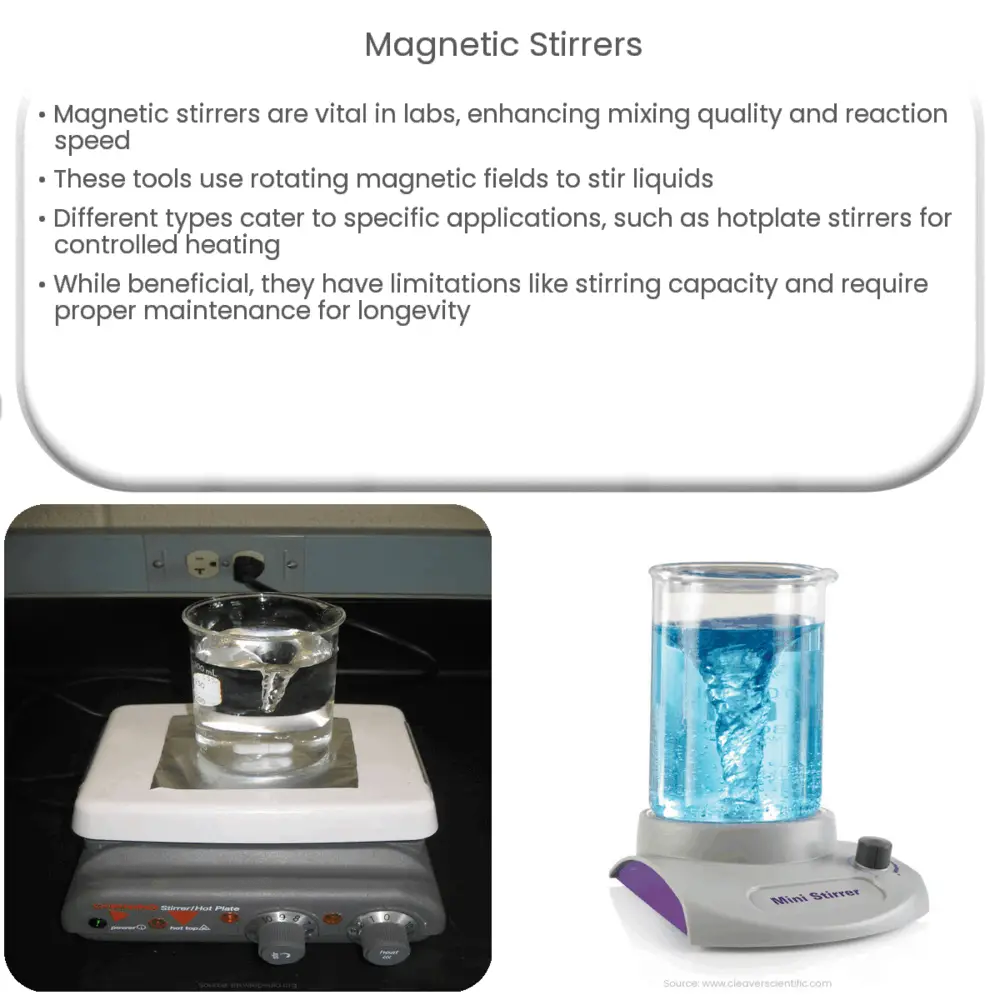Discover the importance of magnetic stirrers in modern laboratories, their types, benefits, uses, limitations, and maintenance.

Magnetic Stirrers: An Indispensable Tool in the Lab
Magnetic stirrers are an essential tool in many scientific laboratories, facilitating a wide variety of experiments and studies. They provide a safe, efficient and reliable means of stirring liquids, significantly improving the quality of mixing and speed of reaction in many chemical and biological procedures. The basic mechanism and operation of magnetic stirrers offer many advantages and understanding them can help optimize their use in a lab setting.
Understanding Magnetic Stirrers
A magnetic stirrer, also known as a magnetic stir plate or magnetic mixer, uses a rotating magnetic field to cause a stir bar immersed in a liquid to spin rapidly, thus stirring it. The core component of a magnetic stirrer is a spinning magnet or a set of stationary electromagnets, creating a rotating magnetic field.
- Base: The base houses the magnetic drive motor and control circuits. It’s typically designed to be stable and sturdy to prevent any accidents while the device is in operation.
- Magnetic drive motor: The heart of the stirrer, it rotates the magnet that induces the stirring motion.
- Control circuits: They regulate the speed of the motor, allowing for precise control of the stirring speed.
Types of Magnetic Stirrers
Magnetic stirrers come in different types, each suited to specific applications:
- Hotplate magnetic stirrer: This type integrates a hot plate, allowing simultaneous heating and stirring. It’s commonly used in experiments that require controlled heating.
- Multi-position magnetic stirrer: It can stir multiple containers at the same time, making it perfect for high-throughput applications.
- Stirring rods and bars: Different shapes and sizes of stirring rods and bars are used depending on the size and type of container, and the viscosity of the liquid.
In the next section, we’ll delve into the benefits and uses of magnetic stirrers, as well as their potential limitations and safety considerations.
Benefits and Uses of Magnetic Stirrers
Magnetic stirrers provide a host of benefits, making them incredibly versatile tools in the laboratory. They offer precise control over the stirring speed and, in the case of hotplate magnetic stirrers, the temperature as well. This is essential in many experiments where consistency and control are paramount. Furthermore, their simple, reliable design leads to reduced maintenance needs.
From the pharmaceutical and food industries to academic research and chemical manufacturing, the applications of magnetic stirrers are widespread. They are commonly used in titration, sample preparation, colloidal dispersion, cell culture, and more.
Limitations and Safety Considerations
Despite their many advantages, magnetic stirrers do have limitations. Their stirring capacity is limited by the size of the magnetic field and stir bar. For very viscous liquids or large volumes, mechanical stirrers may be more effective.
Safety is a key consideration when using magnetic stirrers. With hotplate models, it’s crucial to handle the device correctly to prevent burns. Additionally, the stirring bar should be removed carefully from the solution post-stirring, to avoid spillage or breakage of the container.
Maintaining Magnetic Stirrers
To ensure longevity and efficient operation of a magnetic stirrer, regular maintenance is necessary. This involves routine checks on the equipment, such as verifying the temperature controls and the motor’s function, and cleaning the device after each use.
- Regular checks: Ensure the device is functioning correctly before and after each use.
- Cleaning: After each use, the device should be cleaned to prevent cross-contamination.
- Storage: Store the magnetic stirrer in a safe place to prevent damage.
Conclusion
In conclusion, magnetic stirrers are essential tools in modern laboratories, contributing greatly to the efficiency and safety of various experiments. They offer a simple yet powerful method of stirring, adaptable to numerous applications across diverse fields. Despite some limitations, their benefits far outweigh the drawbacks, and with proper usage and maintenance, they can significantly enhance the laboratory work process.

